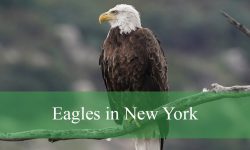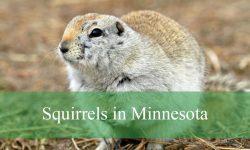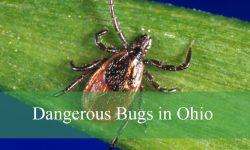Walking through Tennessee’s forests, fields, and river valleys, it’s impossible not to notice the presence of hawks gliding above or perched silently on tall trees. Each species carries a story, from the commanding Red-tailed Hawk surveying the landscape to the darting Sharp-shinned Hawk weaving through dense woods.
The state’s changing seasons bring dynamic raptor activity. In spring and fall, Broad-winged Hawks gather in massive kettles, while winter welcomes visitors like the Rough-legged Hawk to open farmlands. Observing them requires patience, a keen eye, and an appreciation for the grace and precision of these aerial hunters.
Experiencing hawks in their natural habitats is a lesson in adaptation and survival. Noticing subtle differences in size, flight style, and markings transforms casual birdwatching into an engaging adventure, offering intimate glimpses of Tennessee’s most skilled predators.
Types of Hawks Found in Tennessee
Red-tailed Hawk (Buteo jamaicensis)
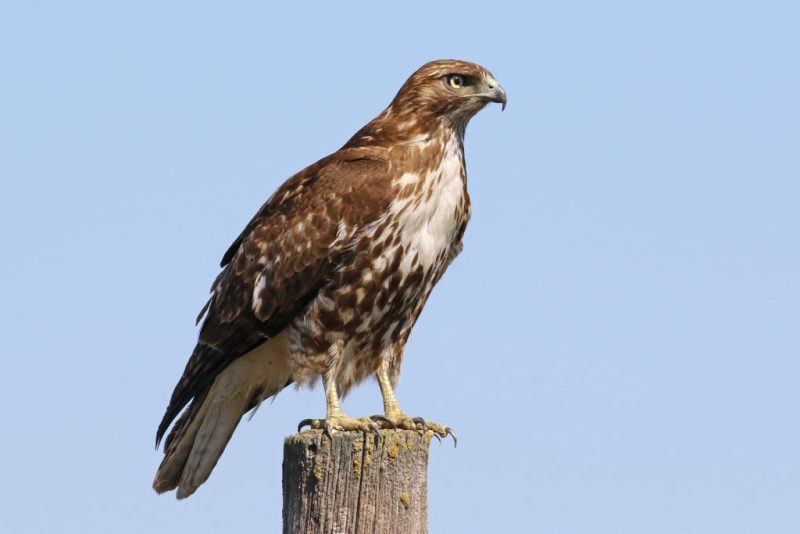
The Red-tailed Hawk is a large, robust raptor commonly seen across Tennessee. Adults measure 18 to 26 inches in length with a wingspan of 43 to 57 inches and weigh between 1.5 and 3.5 pounds. Their broad, rounded wings and distinctive reddish-brown tail make them easily recognizable, while juveniles display a brown, streaked tail.
These hawks are highly adaptable, occupying a variety of habitats including open fields, forest edges, farmlands, and suburban areas. They perch on tall trees or utility poles, scanning for prey such as rodents, rabbits, and snakes, and occasionally take birds or insects.
Red-tailed Hawks are known for their soaring flight and high-pitched, raspy screech. They often circle at great heights, using thermals to conserve energy while searching for prey. Their keen eyesight allows them to detect movement on the ground from far above.
They are widely distributed throughout Tennessee and are resident year-round. Observers frequently spot them along highways, park edges, and open clearings, where they make sudden stoops to capture prey.
The best time to observe Red-tailed Hawks is during daylight, especially in the morning and late afternoon when they are actively hunting. Look for them perched conspicuously or soaring in wide circles against the sky.
Cooper’s Hawk (Accipiter cooperii)
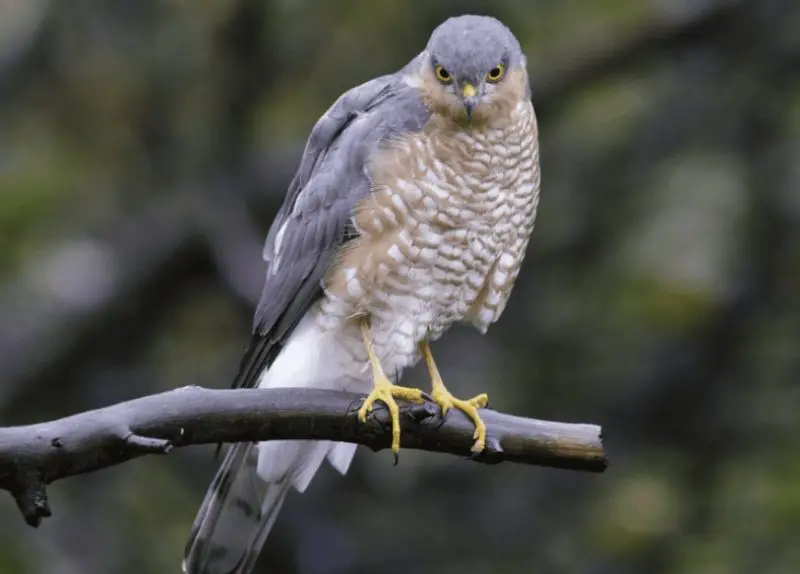
Cooper’s Hawks are medium-sized forest hawks with lengths of 14 to 20 inches, wingspans of 24 to 35 inches, and weights ranging from 8 to 24 ounces. They have a blue-gray back, reddish barring on the chest, and a long, rounded tail with dark bands. Juveniles appear browner with streaked underparts.
They are highly agile hunters, specializing in catching medium-sized birds. Cooper’s Hawks navigate dense forests with quick, darting flights, making sudden pursuits through trees. They have also adapted well to suburban environments, often hunting near bird feeders.
Cooper’s Hawks are territorial and generally solitary outside the breeding season. They hunt primarily during daylight, relying on stealth and speed to surprise prey. Their flight is characterized by rapid wingbeats interspersed with glides, especially when weaving through wooded areas.
These hawks are resident throughout Tennessee, most commonly found in forests, wooded parks, and suburban neighborhoods. Migratory populations can also be observed during spring and fall, though many individuals remain year-round.
For the best viewing opportunities, check feeders or forest edges in early morning or late afternoon, when hunting activity is high. Patience is key, as these hawks often remain hidden until actively chasing prey.
Sharp-shinned Hawk (Accipiter striatus)
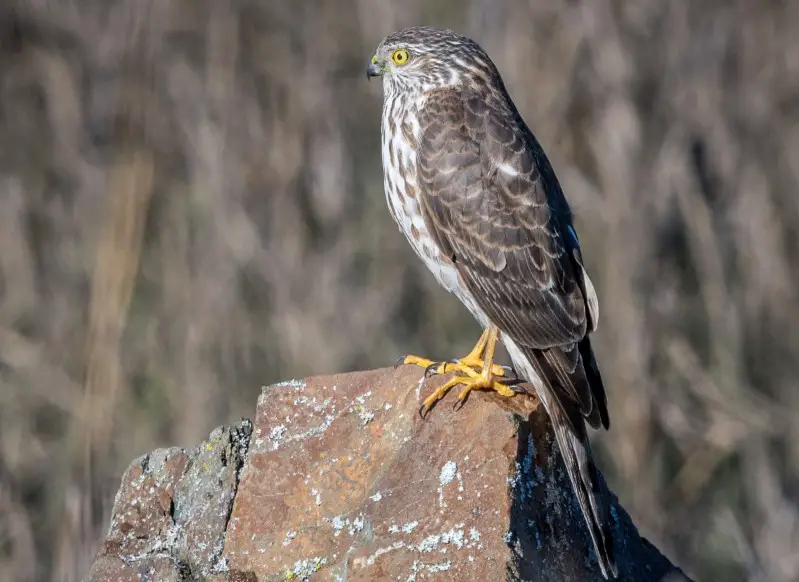
The Sharp-shinned Hawk is Tennessee’s smallest accipiter, measuring 9 to 13 inches in length, with a wingspan of 17 to 23 inches and weighing just 3 to 7 ounces. They have short, rounded wings and a long, narrow tail with several dark bands, providing incredible maneuverability in forests. Adults have orange-barred chests, while juveniles are brown with streaked underparts.
This species is a stealthy predator, feeding almost exclusively on small birds like sparrows and finches. Sharp-shinned Hawks use short, rapid flights and sharp turns to ambush prey among dense trees. Their small size allows them to slip unnoticed through branches, making them elusive and hard to spot.
Sharp-shinned Hawks are generally solitary and highly secretive. They are more often heard than seen, particularly during migration when small flocks move through Tennessee. Their flight appears quick and bounding, with rapid wingbeats followed by glides.
These hawks are widely distributed across Tennessee, especially in forested areas, wooded valleys, and suburban backyards. They are migratory in northern regions, passing through in spring and fall, while some remain as winter residents.
The best time to observe Sharp-shinned Hawks is during winter at bird feeders, when they hunt small birds more openly. During migration, look for them darting through treetops or soaring briefly above the forest canopy.
Broad-winged Hawk (Buteo platypterus)
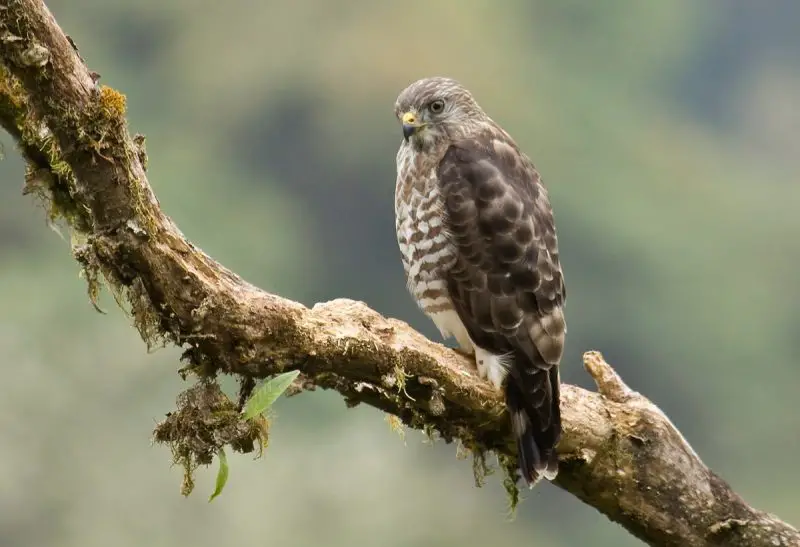
Broad-winged Hawks are small, stocky raptors with lengths of 13 to 17 inches, wingspans of 29 to 39 inches, and weights between 12 and 24 ounces. Adults have rich brown upperparts, pale underparts with fine barring, and a tail with narrow dark bands. Juveniles show streaked underparts and more muted plumage.
This species is highly social, particularly during migration. In fall, thousands of Broad-winged Hawks form “kettles,” soaring together on thermals as they travel to Central and South America. They hunt small mammals, amphibians, reptiles, and insects, usually from high perches or soaring flight.
Broad-winged Hawks prefer deciduous and mixed forests, often near rivers or wetlands. They are secretive when perched, spending much of the day high in the canopy. Despite their small size, their rapid flapping and soaring flight make them noticeable in groups.
In Tennessee, these hawks are most visible during spring and fall migration, especially in hilly and forested areas of East Tennessee. Resident populations may inhabit forests, but they are far less conspicuous outside of migration.
The best observation period is September to October, when large flocks are moving south. Watching from ridge tops or along forested river valleys increases the chances of seeing these hawks soaring together in kettles.
Red-shouldered Hawk (Buteo lineatus)
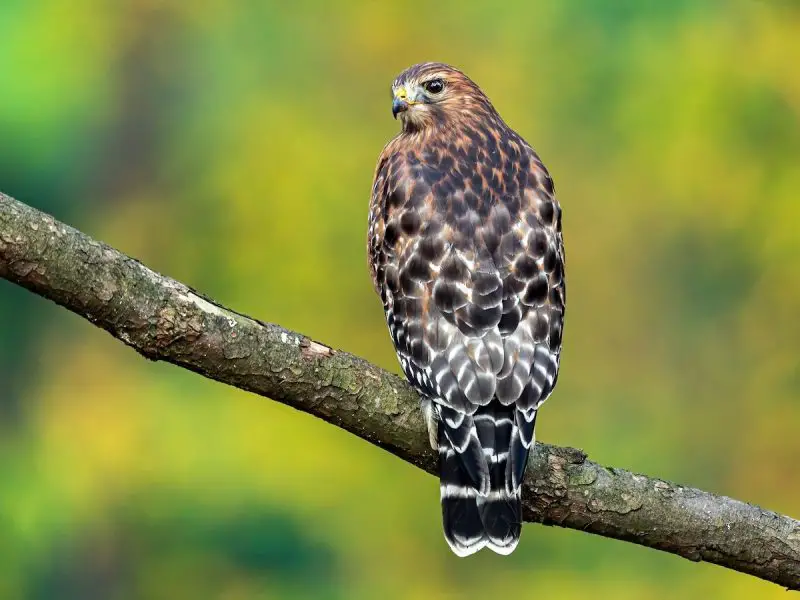
Red-shouldered Hawks are medium-sized buteos, measuring 16 to 19 inches long with wingspans of 37 to 43 inches and weighing 1 to 2 pounds. They have reddish barring on the chest, black-and-white patterned wings, and a long, banded tail. Juveniles are browner with streaked underparts.
They prefer wetland forests, river edges, and wooded suburban areas, often perching near water while hunting frogs, snakes, small mammals, and amphibians. They are highly vocal, with a distinctive, repetitive “kee-aah” call that can alert observers before the bird is seen.
Red-shouldered Hawks are territorial year-round. They hunt from elevated perches, swooping down to catch prey with precision. They are agile flyers, often weaving through trees along creeks and swamps, and are active mostly during daylight.
These hawks are resident throughout Tennessee, particularly in bottomland forests and along rivers. They are more visible during the breeding season, when adults frequently call to establish and defend territories.
The best time to observe Red-shouldered Hawks is in spring and early summer when their vocal activity is high. Look for them perched along forest edges, creek banks, or near wetlands, often gliding low over the treetops in search of prey.
Northern Harrier (Circus hudsonius)
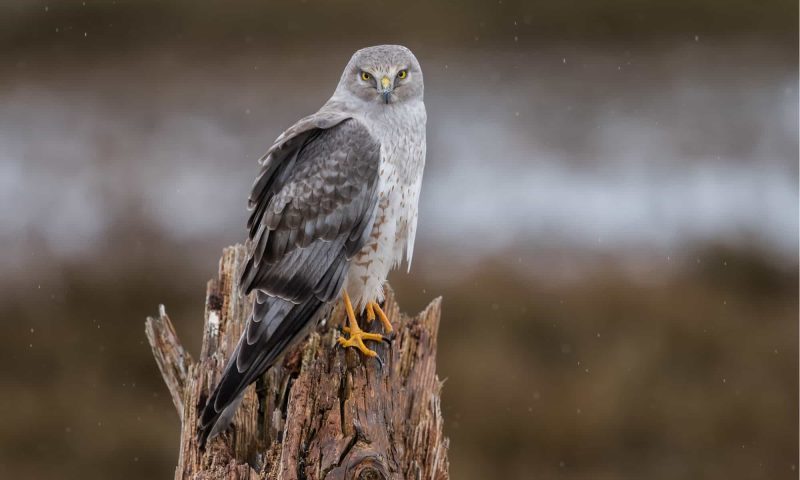
The Northern Harrier is a medium-sized raptor with a length of 17 to 20 inches, wingspan of 40 to 46 inches, and weight ranging from 14 to 22 ounces. Adult males are gray above with a white rump, while females and juveniles are brown with streaked underparts. Their long wings and low-flying hunting style make them easily distinguishable from other hawks.
Northern Harriers are specialized predators of open habitats, gliding low over marshes, fields, and grasslands to catch small mammals and birds. Their flight is buoyant and rhythmic, often with wings held in a slight V-shape. They rely on keen hearing and eyesight to detect prey hidden in tall grasses.
These harriers are mostly solitary and highly alert while hunting. They nest on the ground within dense vegetation, making them more secretive during the breeding season. Their courtship displays include dramatic low flights and circling above marshes.
Northern Harriers are widely distributed in Tennessee, particularly in the western and central regions during winter and in open wetlands during the breeding season. Migrants may also pass through in spring and fall.
The best time to observe Northern Harriers is in late winter and early spring in open fields, grasslands, or marshes. Look for their slow, gliding flight just above the vegetation, often with the characteristic white rump flashing as they turn.
Rough-legged Hawk (Buteo lagopus)
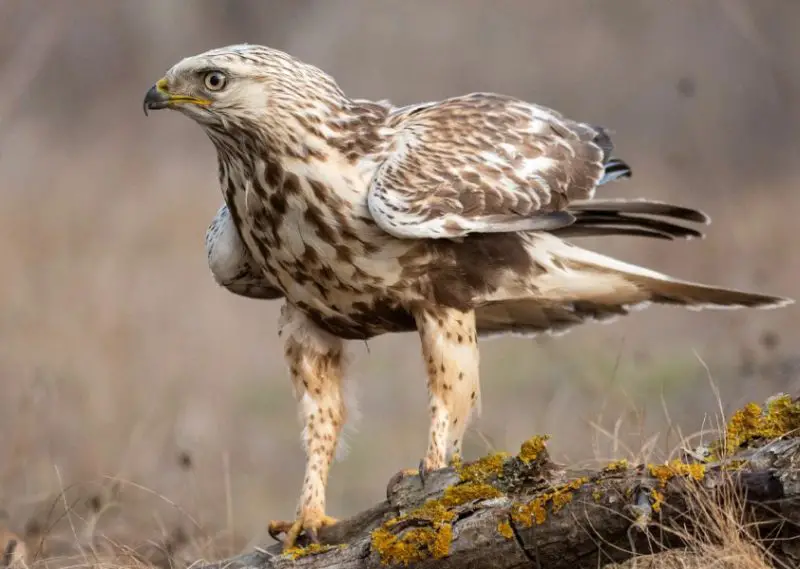
Rough-legged Hawks are large buteos with lengths of 19 to 24 inches, wingspans of 52 to 60 inches, and weights of 1.5 to 3.5 pounds. They have broad wings, a long tail, and feathered legs that extend down to their toes, which is a distinctive identification feature. Plumage varies from light to dark morphs, with heavily patterned underparts and a pale belly in most individuals.
This species is a winter visitor in Tennessee, migrating from Arctic and subarctic breeding grounds. Rough-legged Hawks prefer open fields, prairies, and agricultural areas, hunting small mammals such as voles and mice. They hover briefly while scanning for prey, a behavior rarely seen in other buteos.
They are solitary hunters, often patrolling the same territory throughout the winter months. Their flight is slow and deliberate, with occasional hovering, making them appear heavier than other mid-sized hawks.
Rough-legged Hawks are uncommon in Tennessee, mainly seen during winter from November to March. Observations are more likely in northern and western agricultural counties where open fields dominate the landscape.
The best time to observe Rough-legged Hawks is on bright, cold winter days when they hunt in open farmland. Watch for their distinctive hovering behavior and long, feathered legs that extend toward the ground as they scan for rodents.
Swainson’s Hawk (Buteo swainsoni)
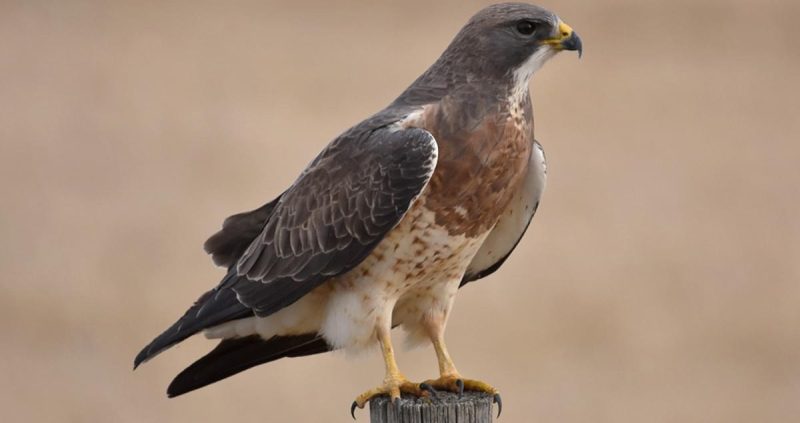
Swainson’s Hawks are medium-sized migratory raptors with lengths of 18 to 22 inches, wingspans of 46 to 56 inches, and weights of 1.5 to 2.5 pounds. Adults have dark brown backs, pale underparts with streaked breast, and a lighter face. Juveniles appear uniformly brown with less distinctive markings.
This species primarily inhabits grasslands, prairies, and agricultural fields, hunting insects, small mammals, and occasionally birds. Swainson’s Hawks are known for long migrations, traveling from North American breeding grounds to wintering areas in South America.
They are gregarious during migration, often forming large flocks while traveling south. While in Tennessee, they may hunt alone or in loose groups, soaring with slow wingbeats and occasionally circling thermals.
Swainson’s Hawks are rare in Tennessee, usually appearing as migrants in late spring or early fall. Sightings are scattered and unpredictable, mostly in open farmland or fields where prey is abundant.
The best time to observe Swainson’s Hawks is during migration in April–May or September–October. Look for them soaring high above fields or along forest edges, often in small groups or kettles during their journey.
Ferruginous Hawk (Buteo regalis)
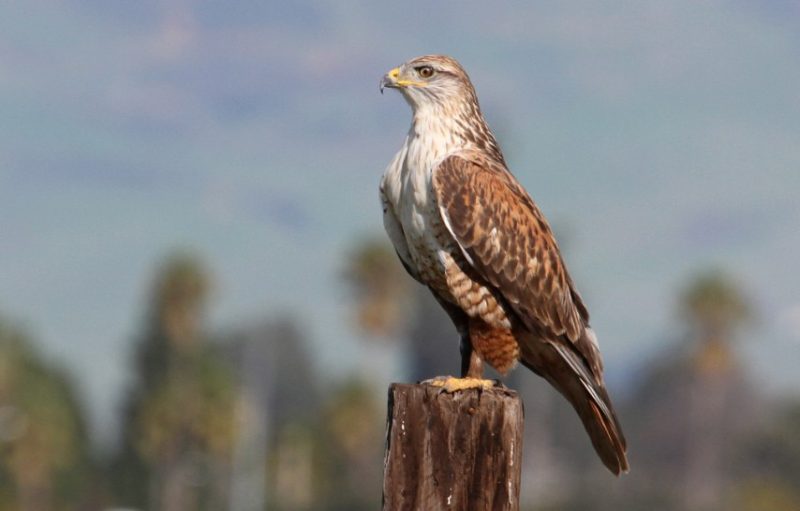
Ferruginous Hawks are large, powerful buteos with lengths of 20 to 27 inches, wingspans of 52 to 60 inches, and weights between 2 and 4 pounds. Adults have rusty-colored back and shoulders, pale underparts, and a distinctive broad tail with subtle banding. Juveniles are paler with streaked underparts.
This species inhabits open plains and deserts in the western United States but is an extremely rare vagrant in Tennessee. It hunts primarily small mammals, including rabbits, ground squirrels, and prairie dogs, relying on soaring flight to locate prey.
Ferruginous Hawks are solitary and territorial when present, with strong, steady flight and occasional hovering. Their large size and rusty plumage make them striking when observed, even at long distances.
In Tennessee, Ferruginous Hawks are very rare, with only a handful of verified sightings in open fields or along rural roads. They typically appear in late fall or winter when wandering individuals arrive outside their usual range.
The best time to observe Ferruginous Hawks in Tennessee is during winter, focusing on large, open agricultural fields or pastures where lone birds may hunt. Patience is key, as sightings are infrequent and unpredictable.
Zone-tailed Hawk (Buteo albonotatus)
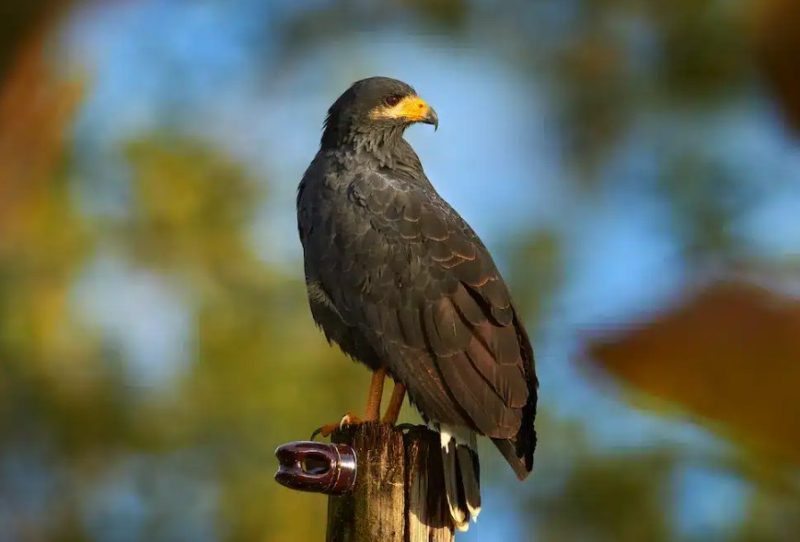
The Zone-tailed Hawk is a medium-sized raptor with lengths of 17 to 22 inches, wingspans of 42 to 48 inches, and weights of 1 to 2 pounds. Adults are dark brown with narrow white bands on the tail and are sometimes mistaken for turkey vultures due to their similar flight style and coloring. Juveniles are lighter with streaked underparts.
This species prefers open woodlands, desert edges, and mountainous areas, hunting small mammals, birds, and reptiles. Its flight is slow and deliberate, often soaring with wings held in a slight dihedral, similar to vultures, which helps it blend in while approaching prey.
Zone-tailed Hawks are solitary hunters and are known for their stealth, often surprising prey by gliding silently among soaring vultures. They are generally quiet but may emit a high-pitched call when alarmed.
In Tennessee, Zone-tailed Hawks are accidental visitors, with very few confirmed sightings in the southern and western parts of the state. Most individuals are wandering adults outside their typical southwestern range.
The best time to observe Zone-tailed Hawks is during rare winter or migration sightings, typically in open woodlands or sparsely forested areas. Observers should watch for a dark hawk gliding among turkey vultures to spot this elusive species.
Frequently Asked Questions About Hawks in Tennessee
What types of hawks can be found in Tennessee?
Tennessee hosts a variety of hawk species, including the Red-tailed Hawk, Cooper’s Hawk, Sharp-shinned Hawk, Broad-winged Hawk, Red-shouldered Hawk, Northern Harrier, Rough-legged Hawk, Swainson’s Hawk, Ferruginous Hawk, and Zone-tailed Hawk. Some are year-round residents, while others are seasonal migrants or rare visitors.
When is the best time to observe hawks in Tennessee?
The best time to observe hawks varies by species. Resident species like Red-tailed Hawks and Cooper’s Hawks can be seen year-round, while migratory species such as Broad-winged Hawks are most visible during spring and fall migration. Winter visitors, like Rough-legged Hawks, are best spotted from November to March. Early morning and late afternoon are ideal hours for active hunting and soaring behavior.
Where should I look for hawks in Tennessee?
Hawks are often found in forests, open fields, farmlands, wetlands, and along river edges. Perches on tall trees, utility poles, and fence posts are common observation points. Migratory species may be seen soaring above ridges, valleys, or thermals during migration. Wetlands and marshes are ideal for Northern Harriers and Red-shouldered Hawks.
How can I identify different hawk species?
Identification relies on size, plumage, wing shape, tail pattern, flight style, and behavior. For example, Red-tailed Hawks have broad wings and a brick-red tail, Cooper’s Hawks are medium-sized with rounded tails and reddish chest bars, and Sharp-shinned Hawks are small with narrow, banded tails. Flight behavior, such as soaring, flapping, or gliding among thermals, also helps differentiate species.
Are any hawks in Tennessee endangered or protected?
All hawks in Tennessee are protected under the Migratory Bird Treaty Act, which prohibits hunting, capturing, or disturbing these birds without proper permits. While most hawks are not endangered, habitat loss and environmental changes can impact local populations, making conservation of forests, wetlands, and open fields important.
Can I attract hawks to my backyard?
While hawks are not typically attracted to feeders like songbirds, providing open spaces and perches can encourage hunting activity near your property. Native small mammals and birds naturally attract raptors. Avoid direct feeding, as it can disrupt natural hunting behaviors.
How do migratory hawks travel through Tennessee?
Many species, like Broad-winged Hawks, migrate in large groups called “kettles,” soaring on thermals to conserve energy. Migration occurs primarily in spring (March–May) and fall (August–October). Observers can spot these hawks from high vantage points, ridges, or along river valleys where thermals are strongest.


